初中英语重要句型及语法详细汇总
- 格式:pdf
- 大小:40.25 KB
- 文档页数:16
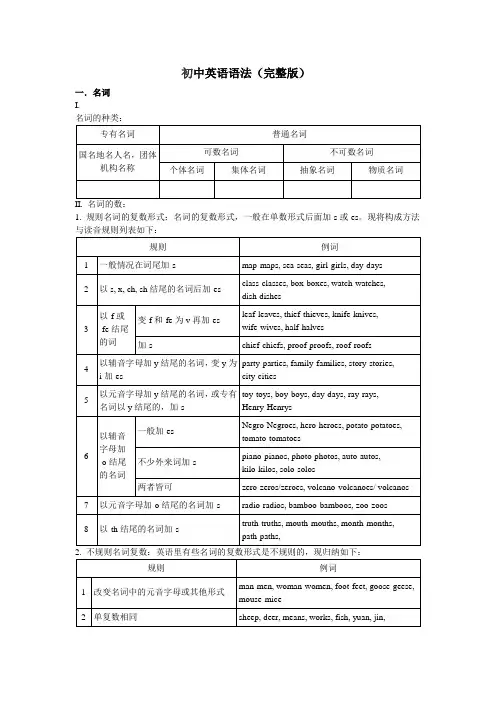
初中英语语法(完整版)一.名词I.名词的种类:II. 名词的数:1. 规则名词的复数形式:名词的复数形式,一般在单数形式后面加-s或-es。
现将构成方法与读音规则列表如下:III. 名词的所有格:名词在句中表示所有关系的语法形式叫做名词所有格。
所有格分两种:一是名词词尾加’s 构成,二是由介词of加名词构成。
前者多表示有生命的东西,后者多表示无生命的东西。
3. of所有格的用法:用于无生命的东西:the legs of the chair, the cover of the book用于有生命的东西,尤其是有较长定语时:the classrooms of the first-year students 用于名词化的词:the struggle of the oppressed二.冠词冠词分为不定冠词(a, an),定冠词(the),和零冠词。
I.I.代词可以分为以下七大类:II. 不定代词用法注意点:1. one, some与any:1) one可以泛指任何人,也可特指,复数为ones。
some多用于肯定句,any多用于疑问句和否定句。
One should learn to think of others.Have you any bookmarks? No, I don’t have any bookmarks.I have some questions to ask.2) some可用于疑问句中,表示盼望得到肯定的答复,或者表示建议,请求等。
Would you like some bananas?Could you give me some money?3) some 和any修饰可数名词单数时,some表示某个,any表示任何一个。
I have read this article in some magazine.Please correct the mistakes, if any.4) some和数词连用表示“大约”,any可与比较级连用表示程度。
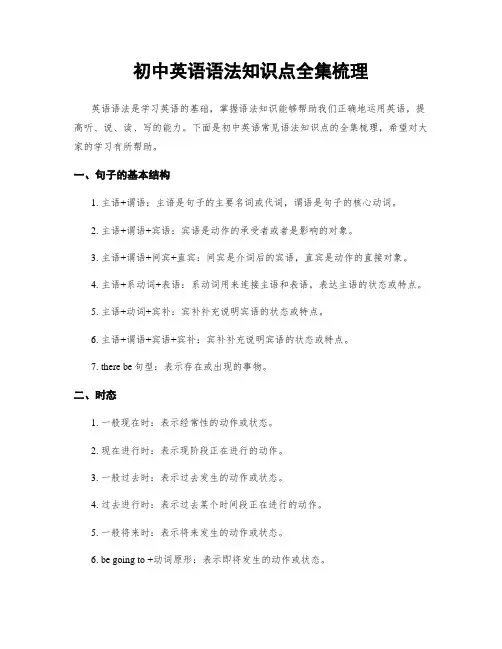
初中英语语法知识点全集梳理英语语法是学习英语的基础,掌握语法知识能够帮助我们正确地运用英语,提高听、说、读、写的能力。
下面是初中英语常见语法知识点的全集梳理,希望对大家的学习有所帮助。
一、句子的基本结构1. 主语+谓语:主语是句子的主要名词或代词,谓语是句子的核心动词。
2. 主语+谓语+宾语:宾语是动作的承受者或者是影响的对象。
3. 主语+谓语+间宾+直宾:间宾是介词后的宾语,直宾是动作的直接对象。
4. 主语+系动词+表语:系动词用来连接主语和表语,表达主语的状态或特点。
5. 主语+动词+宾补:宾补补充说明宾语的状态或特点。
6. 主语+谓语+宾语+宾补:宾补补充说明宾语的状态或特点。
7. there be句型:表示存在或出现的事物。
二、时态1. 一般现在时:表示经常性的动作或状态。
2. 现在进行时:表示现阶段正在进行的动作。
3. 一般过去时:表示过去发生的动作或状态。
4. 过去进行时:表示过去某个时间段正在进行的动作。
5. 一般将来时:表示将来发生的动作或状态。
6. be going to +动词原形:表示即将发生的动作或状态。
7. 现在完成时:表示过去发生的动作对现在造成的影响。
8. 完成进行时:表示过去某个时间段一直持续的动作,强调持续时间。
三、语态1. 主动语态:强调主语是动作的执行者。
2. 被动语态:强调主语是动作的承受者。
四、引导词1. 关系代词:用来连接主句和从句,并在从句中充当句子成分。
2. 关系副词:用来引导定语从句,修饰前面的名词。
3. 连接代词:用来连接主句和从句,作为从句的主语或宾语。
4. 连接副词:用来连接主句和从句,修饰从句中的动词、形容词或副词。
五、名词1. 可数名词:表示可以用数目词来计数的名词。
2. 不可数名词:表示不可以用数目词来计数的名词。
3. 特殊名词:由复数形式表示一个整体的名词。
4. 形容词+名词:形容词修饰名词。
5. 名词+名词:第一个名词修饰第二个名词。
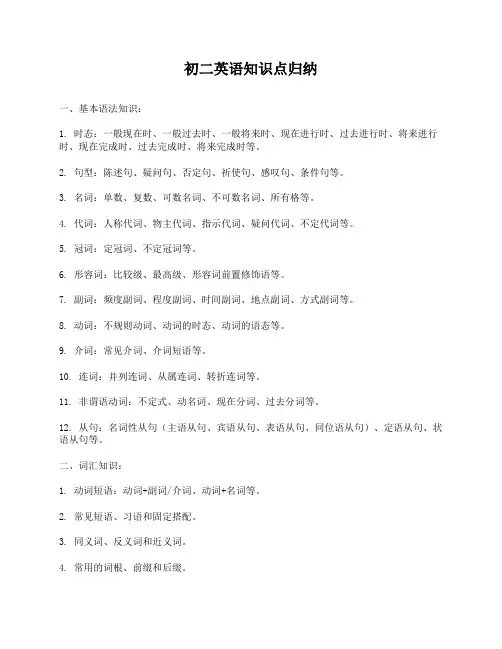
初二英语知识点归纳一、基本语法知识:1. 时态:一般现在时、一般过去时、一般将来时、现在进行时、过去进行时、将来进行时、现在完成时、过去完成时、将来完成时等。
2. 句型:陈述句、疑问句、否定句、祈使句、感叹句、条件句等。
3. 名词:单数、复数、可数名词、不可数名词、所有格等。
4. 代词:人称代词、物主代词、指示代词、疑问代词、不定代词等。
5. 冠词:定冠词、不定冠词等。
6. 形容词:比较级、最高级、形容词前置修饰语等。
7. 副词:频度副词、程度副词、时间副词、地点副词、方式副词等。
8. 动词:不规则动词、动词的时态、动词的语态等。
9. 介词:常见介词、介词短语等。
10. 连词:并列连词、从属连词、转折连词等。
11. 非谓语动词:不定式、动名词、现在分词、过去分词等。
12. 从句:名词性从句(主语从句、宾语从句、表语从句、同位语从句)、定语从句、状语从句等。
二、词汇知识:1. 动词短语:动词+副词/介词、动词+名词等。
2. 常见短语、习语和固定搭配。
3. 同义词、反义词和近义词。
4. 常用的词根、前缀和后缀。
5. 一些常见的词汇拼写规则和变形规则。
6. 数字、日期、星期、时间、颜色、动物、食物、家庭成员、学科、国家和城市等。
三、阅读理解:1. 根据文章内容回答问题。
2. 根据文章中的信息进行推测、判断或总结。
3. 理解文章的主旨、目的、态度、观点等。
4. 根据文章的语境理解词义。
5. 了解不同类型的文体特征和写作方式。
四、写作能力:1. 书面表达:写信、写日记、写作文等。
2. 口头表达:简单介绍、自我介绍、描述事物等。
3. 语法运用:正确使用时态、人称、冠词、代词等。
4. 语言表达:丰富的词汇、恰当的句型、流畅的语言。
五、听力技能:1. 听懂并获取关键信息。
2. 根据对话或短文回答问题。
3. 听懂人物之间的对话和交流。
4. 培养对英语语音和语调的感觉。
六、口语交流:1. 学会问问题和回答问题。
2. 学会用英语进行简单的交流和沟通。
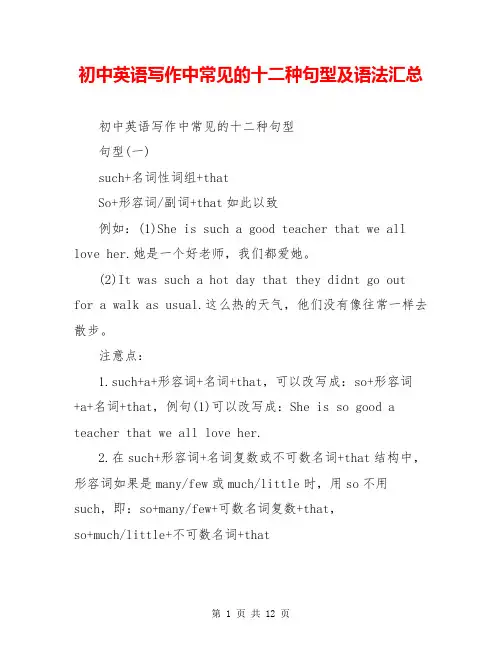
初中英语写作中常见的十二种句型及语法汇总初中英语写作中常见的十二种句型句型(一)such+名词性词组+thatSo+形容词/副词+that如此以致例如:(1)She is such a good teacher that we all love her.她是一个好老师,我们都爱她。
(2)It was such a hot day that they didnt go out for a walk as usual.这么热的天气,他们没有像往常一样去散步。
注意点:1.such+a+形容词+名词+that,可以改写成:so+形容词+a+名词+that,例句(1)可以改写成:She is so good a teacher that we all love her.2.在such+形容词+名词复数或不可数名词+that结构中,形容词如果是many/few或much/little时,用so不用such,即:so+many/few+可数名词复数+that,so+much/little+不可数名词+that(1)There are so many people in the room that I cant get in.房间里人太多,我进不去。
(2)The man has so much money that he can buy a car.那人很有钱,他能买一辆小汽车。
句型(二)There be,eitheror,neithernor,not onlybut also例如:(1)There is a pen and two pencils in his pencil-box.他的铅笔盒里有一支钢笔和两支铅笔。
(2)Not only you but also I have been to the Great Wall.你和我都没有去过长城。
(3)Either you or I am leaving for Shanghai.要么你去上海,要么我去上海。
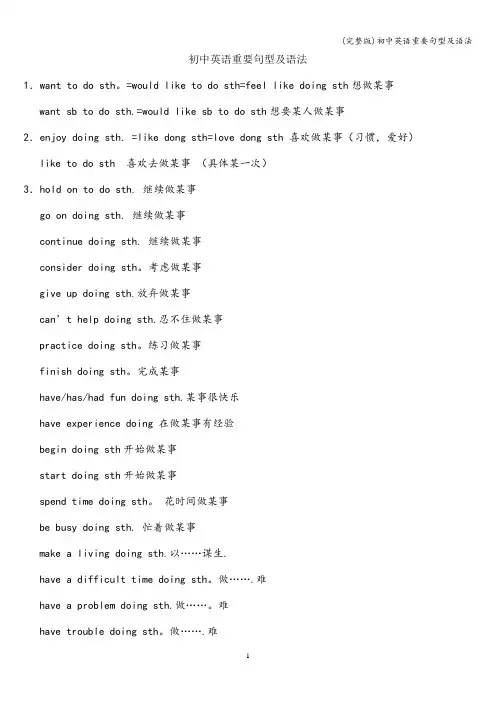
初中英语重要句型及语法1.want to do sth。
=would like to do sth=feel like doing sth想做某事want sb to do sth.=would like sb to do sth想要某人做某事2.enjoy doing sth. =like dong sth=love dong sth 喜欢做某事(习惯,爱好)like to do sth 喜欢去做某事(具体某一次)3.hold on to do sth. 继续做某事go on doing sth. 继续做某事continue doing sth. 继续做某事consider doing sth。
考虑做某事give up doing sth.放弃做某事can’t help doing sth.忍不住做某事practice doing sth。
练习做某事finish doing sth。
完成某事have/has/had fun doing sth.某事很快乐have experience doing 在做某事有经验begin doing sth开始做某事start doing sth开始做某事spend time doing sth。
花时间做某事be busy doing sth. 忙着做某事make a living doing sth.以……谋生.have a difficult time doing sth。
做…….难have a problem doing sth.做……。
难have trouble doing sth。
做…….难keep on doing sth. = keep sb. doing sth。
不停地做某事4.be good at doing sth 擅长于做某事do well in doing sth擅长于做某事thank you for doing sth 感谢做某事thanks for doing sth感谢做某事be used for doing sth 被用于做某事be used to doing sth 习惯做某事how about doing sth 做某事怎样what about doing sth 做某事怎样put off doing sth推迟做某事take pride in doing sth.以……为自豪by doing sth通过做某事be afraid to do sth害怕做某事be afraid of doing sth害怕做某事be terrified of doing sth. 害怕做某事5.be doing sth。
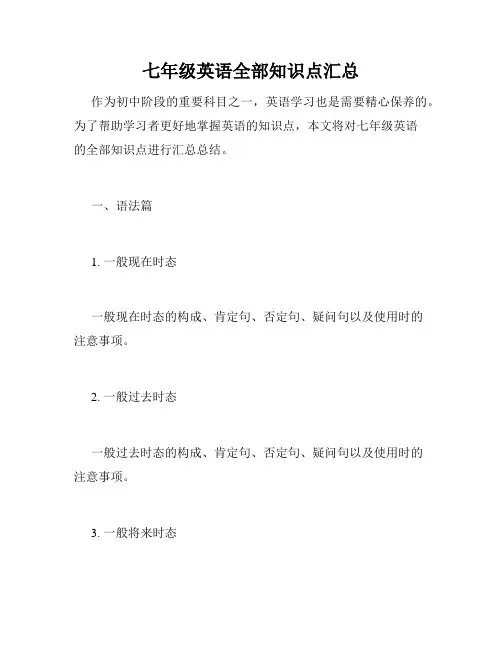
七年级英语全部知识点汇总作为初中阶段的重要科目之一,英语学习也是需要精心保养的。
为了帮助学习者更好地掌握英语的知识点,本文将对七年级英语的全部知识点进行汇总总结。
一、语法篇1. 一般现在时态一般现在时态的构成、肯定句、否定句、疑问句以及使用时的注意事项。
2. 一般过去时态一般过去时态的构成、肯定句、否定句、疑问句以及使用时的注意事项。
3. 一般将来时态一般将来时态的构成、肯定句、否定句、疑问句以及使用时的注意事项。
4. there be句型there be句型的构成、使用时的注意事项、肯定句、否定句、疑问句以及其在生活中的应用。
5. 情态动词情态动词的种类、用法、肯定句、否定句、疑问句以及在不同语境中的使用。
二、词汇篇1. 常用动词常用动词的用法、特点、时态及常见搭配。
2. 常用名词常用名词的分类、用法、大小写及常见搭配。
3. 常用形容词常用形容词的种类、修饰范围、时态及常见搭配。
4. 常用副词常用副词的种类、用法、修饰范围、时态及常见搭配。
5. 介词短语介词短语的种类、用法、修饰范围、时态及常见搭配。
三、听说读写篇1. 听力听力训练的方法、技巧以及注意事项。
2. 口语口语训练的方法、技巧、句型及常见会话场景。
3. 阅读阅读技巧、记笔记方法、阅读理解及常用阅读材料。
4. 写作写作技巧、常用句型及作文类型。
四、常用句型篇1.表达喜欢和不喜欢的常用句型表达自己的兴趣、爱好及个人喜好的常用英语句型。
2.谈论家庭的常用句型介绍自己的家庭成员、家庭状况及其他相关事宜的常用英语句型。
3.表达时间和日常安排的常用句型谈论日常安排及时间安排,以及在表达时间时常用的句型。
4.谈论旅游和活动的常用句型谈论自己喜欢的旅游目的地、旅游方式及其他活动,以及在此类话题中常用的句型。
五、常用短语篇1. 常用问候语适用于各种场合的常见问候语及相应回答。
2. 商务用语适用于商务活动中的常见用语,例如谈判、面试、签约等。
3. 用于旅游的短语适用于各种旅游场合,例如订酒店、租车、询问路线等。

史上最全的中考英语语法必考知识点大全
一、时态
1.一般现在时:叙述现在地基本情况及习惯性动作,主动形式表示现在状态或现在客观存在的事实。
2.一般过去时:表示过去其中一时间发生的动作和存在的状态。
3.现在完成时:表示从过去其中一时间开始,一直延续到现在的动作或状态。
4.现在进行时:表示此刻正在发生的动作或存在的状态。
5.一般将来时:表示将来其中一时刻或其中一段时间内发生的动作或存在的状态。
6.过去将来时:表示过去时预计或计划将来要发生的动作或存在的状态。
7.状语从句中的时态:
(1)主句是一般现在时,从句一般用一般现在时;
(2)主句是一般过去时,从句一般用一般过去时;
(3)主句是一般将来时,从句一般用一般将来时;
(4)主句是现在完成时,从句一般用过去将来时。
二、句法结构
1.主谓一致:谓语动词表达的动作所发生的时间和主语之间是一致的关系。
2.主语从句:即用疑问词引导的从句,其主语在句中充当整个句子或者句子成分的主语。
3.主谓宾:即主语、谓语动词和宾语三部分的句子结构。
4.定语从句:即用关联词引导的附加句,其作用是对主句中的一些名词或代词进行补充说明。
5.宾语从句:即用从属连词引导的从句,其作用是把从句的内容作为宾语放在动词后面。
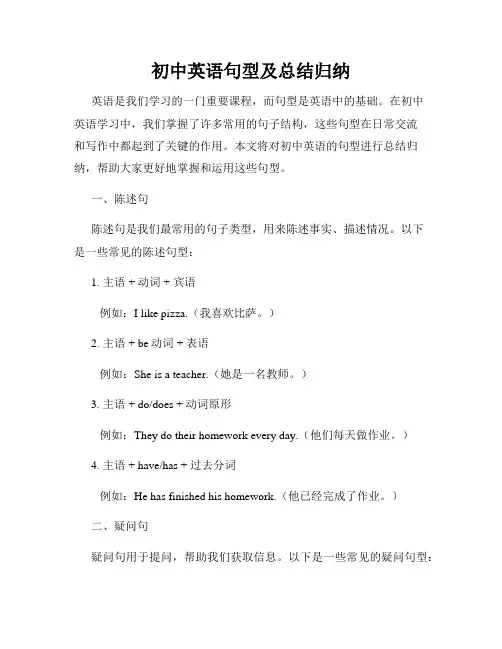
初中英语句型及总结归纳英语是我们学习的一门重要课程,而句型是英语中的基础。
在初中英语学习中,我们掌握了许多常用的句子结构,这些句型在日常交流和写作中都起到了关键的作用。
本文将对初中英语的句型进行总结归纳,帮助大家更好地掌握和运用这些句型。
一、陈述句陈述句是我们最常用的句子类型,用来陈述事实、描述情况。
以下是一些常见的陈述句型:1. 主语 + 动词 + 宾语例如:I like pizza.(我喜欢比萨。
)2. 主语 + be动词 + 表语例如:She is a teacher.(她是一名教师。
)3. 主语 + do/does + 动词原形例如:They do their homework every day.(他们每天做作业。
)4. 主语 + have/has + 过去分词例如:He has finished his homework.(他已经完成了作业。
)二、疑问句疑问句用于提问,帮助我们获取信息。
以下是一些常见的疑问句型:1. 疑问词 + 助动词 + 主语 + 动词?例如:What do you like?(你喜欢什么?)2. 助动词 + 主语 + 动词?例如:Do you play basketball?(你打篮球吗?)3. 特殊疑问句例如:Where did you go yesterday?(你昨天去哪里了?)三、祈使句祈使句用于表达请求、命令或建议。
以下是一些常见的祈使句型:1. 动词原形 + 其他成分例如:Open the window, please.(请打开窗户。
)2. 动词原形 + 不定代词/名词例如:Eat some fruit.(吃些水果。
)四、感叹句感叹句用于表达惊讶、赞美、喜悦等情感。
以下是一些常见的感叹句型:1. How + 形容词/副词 + 主语 + 动词!例如:How beautiful the flowers are!(花儿多美啊!)2. What + 形容词 + 名词 + 主语 + be动词!例如:What a lovely dog he has!(他有一只多可爱的狗啊!)五、条件句条件句用于表达假设、条件和结果之间的关系。
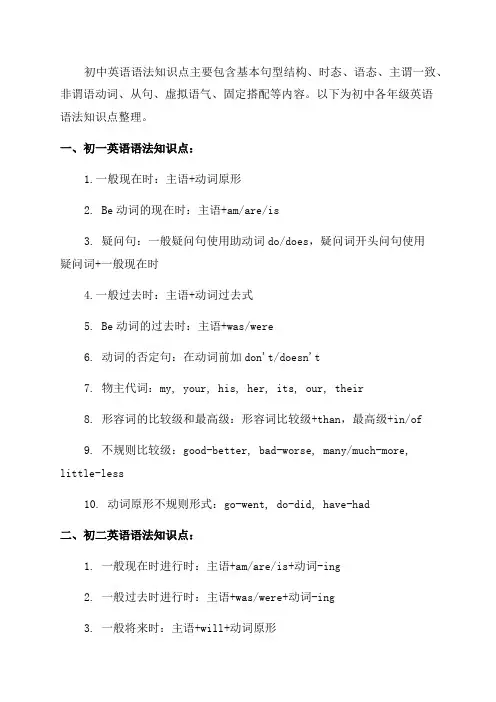
初中英语语法知识点主要包含基本句型结构、时态、语态、主谓一致、非谓语动词、从句、虚拟语气、固定搭配等内容。
以下为初中各年级英语语法知识点整理。
一、初一英语语法知识点:1.一般现在时:主语+动词原形2. Be动词的现在时:主语+am/are/is3. 疑问句:一般疑问句使用助动词do/does,疑问词开头问句使用疑问词+一般现在时4.一般过去时:主语+动词过去式5. Be动词的过去时:主语+was/were6. 动词的否定句:在动词前加don't/doesn't7. 物主代词:my, your, his, her, its, our, their8. 形容词的比较级和最高级:形容词比较级+than,最高级+in/of9. 不规则比较级:good-better, bad-worse, many/much-more,little-less10. 动词原形不规则形式:go-went, do-did, have-had二、初二英语语法知识点:1. 一般现在时进行时:主语+am/are/is+动词-ing2. 一般过去时进行时:主语+was/were+动词-ing3. 一般将来时:主语+will+动词原形4. Be动词的将来时:主语+will be5. 动词的被动语态:be+过去分词6.主谓一致:主语+动词(单复数一致)7.非谓语动词的基本形式:动词原形+不定式作宾语、表语、定语或状语8. 非谓语动词:动词不定式(to do)、现在分词(doing)、过去分词(done)9.名词性从句:宾语从句、主语从句、表语从句10.特殊疑问句:疑问词+一般疑问句11. 虚拟语气:与现在事实相反用过去式;与过去事实相反用过去完成式;与将来事实相反用would/should+动词原形三、初三英语语法知识点:1. 一般现在时的被动语态:主语+am/are/is+过去分词2. 一般过去时的被动语态:主语+was/were+过去分词3. 现在完成时:主语+have/has +过去分词4. 过去完成时:主语+had+过去分词5. 条件句:if+一般现在时,将来时;if+一般过去时,过去时;if+were, would+动词原形6.直接引语和间接引语的转换7. 感叹句:How+形容词/副词+主语+动词!8. 冠词的用法:不定冠词a/an、定冠词the、零冠词9. 情态动词:can, could, may, might, must, shall, should, will, would, had better, need, ought to四、初中英语常见固定搭配:1. look forward to + N/Ving:期待2. be interested in + N/Ving:对…感兴趣3. keep + Ving:一直做事4. help + sb. + V:帮助人做事5. go + Ving:去做事6. have fun/enjoy + Ving:玩得开心/喜欢做事7. be good at + N/Ving:擅长做事8. be afraid of + N/Ving:害怕9. be better off:更富有10. be crazy about + N/Ving:对…痴迷11. It's+adj.+to do:做事怎么样13. be famous for + N/Ving:因…而出名14. be/get used to + N/Ving:习惯于以上是初中各年级英语语法知识点的整理,共计超过1200字。
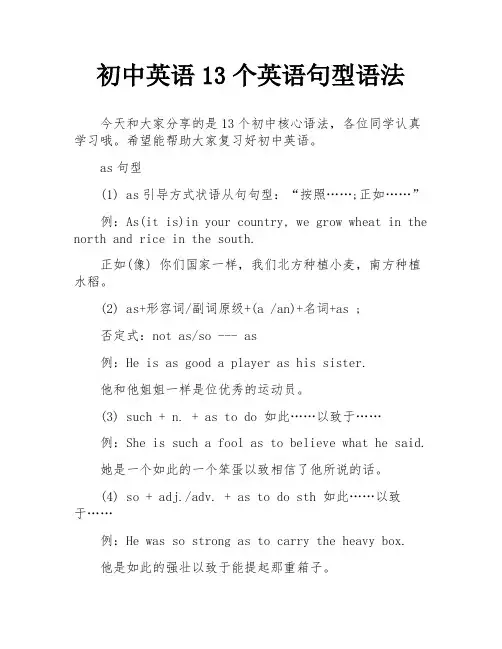
初中英语13个英语句型语法今天和大家分享的是13个初中核心语法,各位同学认真学习哦。
希望能帮助大家复习好初中英语。
as句型(1) as引导方式状语从句句型:“按照……;正如……”例:As(it is)in your country, we grow wheat in the north and rice in the south.正如(像) 你们国家一样,我们北方种植小麦,南方种植水稻。
(2) as+形容词/副词原级+(a /an)+名词+as ;否定式:not as/so --- as例:He is as good a player as his sister.他和他姐姐一样是位优秀的运动员。
(3) such + n. + as to do 如此……以致于……例:She is such a fool as to believe what he said.她是一个如此的一个笨蛋以致相信了他所说的话。
(4) so + adj./adv. + as to do sth 如此……以致于……例:He was so strong as to carry the heavy box.他是如此的强壮以致于能提起那重箱子。
(5) such...as... 象……之类的…… (接名词或定语从句)例:He wished to be such a man as Lei Feng was.他希望成为一个像雷锋这样的人。
(6) the same +名词+as 和……一样的…… (接名词或定语从句)例:He is not the same man as he used to be.他不是从前的那样子了。
(7) as 引导非限制性定语从句例:As is known to us, knowledge is power.众所周知,知识就是力量。
(8)引导时间状语从句,与while意义相近例:We get wiser as we get older.随着我们长大,我们也变得越来越聪明。
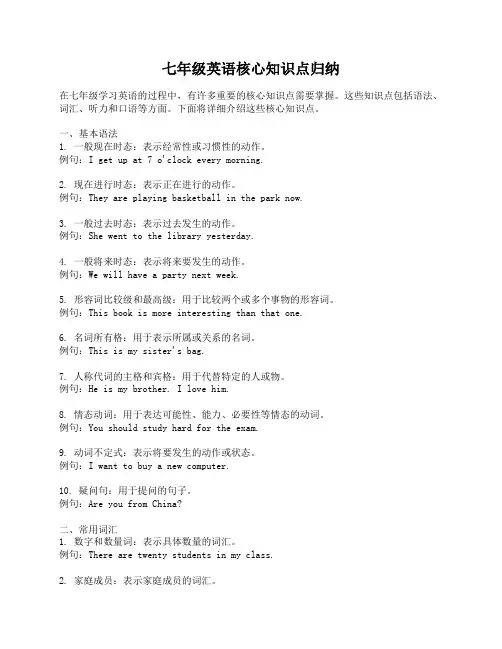
七年级英语核心知识点归纳在七年级学习英语的过程中,有许多重要的核心知识点需要掌握。
这些知识点包括语法、词汇、听力和口语等方面。
下面将详细介绍这些核心知识点。
一、基本语法1. 一般现在时态:表示经常性或习惯性的动作。
例句:I get up at 7 o'clock every morning.2. 现在进行时态:表示正在进行的动作。
例句:They are playing basketball in the park now.3. 一般过去时态:表示过去发生的动作。
例句:She went to the library yesterday.4. 一般将来时态:表示将来要发生的动作。
例句:We will have a party next week.5. 形容词比较级和最高级:用于比较两个或多个事物的形容词。
例句:This book is more interesting than that one.6. 名词所有格:用于表示所属或关系的名词。
例句:This is my sister's bag.7. 人称代词的主格和宾格:用于代替特定的人或物。
例句:He is my brother. I love him.8. 情态动词:用于表达可能性、能力、必要性等情态的动词。
例句:You should study hard for the exam.9. 动词不定式:表示将要发生的动作或状态。
例句:I want to buy a new computer.10. 疑问句:用于提问的句子。
例句:Are you from China?二、常用词汇1. 数字和数量词:表示具体数量的词汇。
例句:There are twenty students in my class.2. 家庭成员:表示家庭成员的词汇。
例句:My father is a doctor. My mother is a teacher.3. 介词短语:用于表示方向、位置等的短语。
七年级英语语法知识总结七年级英语语法知识总结(精选6篇)总结是在某一特定时间段对学习和工作生活或其完成情况, 包括取得的成绩、存在的问题及得到的经验和教训加以回顾和分析的书面材料, 它能使我们及时找出错误并改正, 让我们来为自己写一份总结吧。
那么总结要注意有什么内容呢?以下是小编整理的七年级英语语法知识总结(精选6篇), 供大家参考借鉴, 希望可以帮助到有需要的朋友。
七年级英语语法知识总结篇11.现在进行时表示现在正在进行或发生的动作, 也可表示当前一段时间内的活动或现阶段正在进行的动作。
2.现在进行时的肯定句基本结构为be+动词ing.3.现在进行时的否定句在be后加not。
4.现在进行时的一般疑问句把be动词调到句首5.现在进行时的特殊疑问的基本结构为:疑问词不达意+ be +主语+动词ing?但疑问词当主语时其结构为:疑问词不达意+ be +动词ing?动词加ing的变化规则1.一般情况下, 直接加ing, 如: cook-cooking2.以不发音的e结尾, 去e加ing, 如: make-making, taste- tasting3.如果末尾是一个元音字母和一个辅音字母, 双写末尾的辅音字母, 再加ing, 如:run-running, stop-stopping②will+ do.三、否定句: 在be动词(am, is, are)l后加not或情态动词will后加not成won’t。
例如: I’m going to have a picnic this afternoon.→ I’m not going to have a picnic this afternoon.四、一般疑问句: be或will提到句首, some改为any, and改为or, 第一二人称互换。
例如: We are going to go on an outing this weekend.→ Are you going to go on an outing this weekend?五、对划线部分提问。
初中英语知识点归纳基本句型及语法结构初中英语知识点归纳:基本句型及语法结构英语作为一门外语,初中时期的学习是打下基础的关键阶段。
掌握基本句型和语法结构对于学生的英语学习至关重要。
本文将归纳总结初中英语中的基本句型和语法结构,帮助初学者更好地理解和掌握英语语法知识。
一、基本句型1. 断言句断言句即陈述句,用于陈述一个事实或观点。
基本结构:主语 + 谓语 + 其他成分。
例句:He is a student.(他是一个学生。
)2. 疑问句疑问句用于询问事实、情况、原因等。
基本结构:疑问词/助动词 + 主语 + 谓语 + 其他成分?例句:Where is the library?(图书馆在哪里?)3. 否定句否定句用于表达相反的意思。
基本结构:主语 + be动词/助动词/情态动词 + not + 其他成分。
例句:I am not tired.(我不累。
)二、语法结构1. 一般现在时一般现在时用于表达经常性、普遍性的动作或状态。
结构:主语 + 动词原形/+s/es + 其他成分。
例句:She goes to school every day.(她每天上学。
)2. 一般过去时一般过去时用于表示过去发生的动作或状态。
结构:主语 + 动词过去式 + 其他成分。
例句:He played football yesterday.(他昨天踢足球。
)3. 现在进行时现在进行时用于表示现在正在进行的动作。
结构:主语 + be动词 + 现在分词 + 其他成分。
例句:They are watching a movie.(他们正在看电影。
)4. There be句型There be句型用于存在某人或某物。
结构:There is/are + 某物 + 其他成分。
例句:There is a cat on the table.(桌子上有一只猫。
)三、特殊句型和语法结构1. 祈使句祈使句用于发出命令、请求、建议等。
结构:动词原形+ 其他成分。
初中英语知识点归纳常用句型回顾英语是一门国际语言,也是初中阶段的重要学科之一。
掌握好英语知识点和常用句型对于提高学习成绩和英语口语表达能力都非常重要。
本文将对初中英语常用的知识点和句型进行归纳回顾,帮助同学们更好地掌握英语。
一、基本句型1. 主语 + 谓语动词例句:John plays basketball.2. 主语 + 谓语动词 + 宾语例句:Amy drinks milk.3. 主语 + 谓语动词 + 间接宾语 + 直接宾语例句:She gave me a book.4. 主语 + 谓语动词 + 宾语 + 宾补例句:We elected him class monitor.5. 主语 + 谓语动词 + 宾语 + 宾语补足语例句:I find English interesting.二、时态与语态1. 一般现在时例句:They always go to school by bus.2. 一般过去时例句:She studied hard last night.3. 一般将来时例句:I will visit my grandparents next week.4. 现在进行时例句:He is playing soccer now.5. 现在完成时例句:We have already finished our homework. 6. 被动语态例句:The window was broken by the strong wind.三、疑问句及回答1. 一般疑问句例句:Do you like ice cream?回答:Yes, I do. / No, I don't.2. 特殊疑问句例句:What is your favorite color?回答:My favorite color is blue.3. 反意疑问句例句:You like English, don't you?回答:Yes, I do. / No, I don't.四、比较句型1. 比较级例句:She is taller than her sister.2. 最高级例句:This is the best book I have ever read.五、祈使句和感叹句1. 祈使句例句:Please close the door.注意:祈使句的主语通常省略。
初中英语中的十大重点语法知识点1.谓语动词的时态初中阶段主要学习一般现在时、一般过去时、一般将来时三种时态。
每种时态都有其构成规则和用法,例如一般现在时的构成是主语+动词原形,一般过去时的构成是主语+动词过去式,一般将来时的构成是主语+will+动词原形。
2.被动语态被动语态表示动作的承受者是句子的主语。
初中阶段主要学习一般现在时的被动语态、一般过去时的被动语态和一般将来时的被动语态。
它们的构成分别是am/is/are done、was/were done、will be done。
3.宾语从句宾语从句是句子中的一个从句,作为动词或介词的宾语。
初中阶段主要学习由that引导的宾语从句和由if、whether等引导的宾语从句。
例如:I think (that) she is coming.4.定语从句定语从句是用来修饰名词或代词的从句。
初中阶段主要学习由who、whom、which、that等引导的定语从句。
例如:The girl who is speaking to you is my sister.5.状语从句状语从句是用来表示时间、地点、原因、条件等状语的从句。
初中阶段主要学习由now that、since、because、although、though、if、unless、when、until、while等引导的状语从句。
例如:When I get home, I will call you.6.间接引语间接引语是将直接引语转述为叙述语的一种表达方式。
初中阶段主要学习间接引语的构成和用法,例如:He said that he would go.7.句子分类初中阶段主要学习陈述句、疑问句、祈使句和感叹句四种句子类型。
每种句子类型都有其特点和构成规则,例如疑问句通常以升调结尾,祈使句通常以动词原形开头。
8.名词所有格名词所有格用于表示名词的所有关系。
初中阶段主要学习名词所有格的用法,例如:This is Mary’s book.不定式是一种没有词形变化的词性,具有名词、形容词和副词的功能。
(完整版)初中英语语法知识点归纳本文将为大家归纳总结初中英语语法知识点,旨在帮助初中生更好地掌握英语语法。
时态一般现在时1. 动词原形表示现在的事实或惯。
2. 表示普遍真理、经常性行为或个人常规。
现在进行时1. 表示现在正在进行的动作。
2. 动词+ing形式。
一般过去时1. 表示过去发生的事情。
2. 动词过去式。
过去进行时1. 表示过去某个时间正在进行的动作。
2. was/were + 动词+ing形式。
一般将来时1. 表示将来的动作或状态。
2. will/shall + 动词原形。
语态主动语态1. 表示主语是动作的执行者。
2. 主语 + 动词原形。
被动语态1. 表示主语是动作的承受者。
2. be + 过去分词。
比较级与最高级比较级1. 用于比较两个人或物。
2. 形容词 + er。
最高级1. 用于比较三个或更多人或物。
2. 形容词 + est。
祈使句祈使句1. 表示请求、命令、建议或劝告。
2. 动词原形。
倒装句倒装句1. 将助动词或情态动词提前至主语之前。
2. 系动词be的倒装句:is/am/are/was/were + 主语。
直接引语与间接引语直接引语1. 直接引用他人的话。
2. 用引号将原话括起来。
间接引语1. 用自己的话转述他人的话。
2. 没有引号。
以上是初中英语语法的主要知识点归纳。
希望这份文档能够帮助到您更好地学习和掌握英语语法知识。
初中英语重点句型归纳一、陈述句型1. 主语 + be动词 + 表语例句:I am a student.2. 主语 + 动词 + 宾语例句:Tom likes playing basketball.3. 主语 + 动词 + 间接宾语 + 直接宾语例句:My mother bought me a new book.4. 主语 + 动词 + 宾语 + 宾语补足语例句:We elected him monitor.5. 主语 + 动词 + 宾语 + 宾语补足语 + 宾语补足语例句:They made him chairman.6. 主语 + do/does + not + 动词原形例句:She does not like swimming.7. Do/Does + 主语 + 动词原形例句:Do you like English?8. 主语 + have/has + 过去分词例句:He has finished his homework.9. 主语 + have/has + not + 过去分词例句:They haven't seen the film yet.10. Have/Has + 主语 + 过去分词例句:Have you ever visited Beijing?11. There be句型例句:There is a book on the desk.12. It be + adj. + 不定式例句:It is important to learn English well.13. It is + adj. + for + 人 + to + 不定式例句:It is difficult for me to solve the math problem.二、疑问句型1. Yes/No问句:句型为:Do/Does + 主语 + 动词原形?例句:Do you like English?2. 特殊疑问句:以特殊疑问词(what, where, when, why, who, how等)开头。